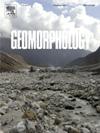秦岭流域分界迁移及其对渭河地堑流域重组和裂谷演化的启示
IF 3.1
2区 地球科学
Q2 GEOGRAPHY, PHYSICAL
引用次数: 0
摘要
中国中部东向秦岭地体和渭河地堑系是青藏高原东北缘和华北东部克拉通之间的重要构造过渡带。然而,该地区地堑-地堑体系和现代水系形态的演化过程尚不清楚。本文基于χ-plot和Gilbert指标分析了秦岭主要分水岭的稳定性,并利用宇宙成因核素10Be数据的流域侵蚀速率估算了分水岭迁移速率。结果表明,秦岭西部的分水岭呈南移趋势,而东部的分水岭基本稳定。认为秦岭水系的迁移受渭河地堑沉降控制,水系稳定性沿走向变化受渭河地堑西扩影响。此外,基于风隙、倒刺支流、风隙附近全新世沉积物和景观数值模拟结果,我们确定了两个主要的河流捕获事件,可能是新生代渭河地堑沉降和秦岭地堑隆升共同造成的。结果表明,在捕获事件发生前,鄂尔多斯南部部分河流曾向南流过秦岭进入四川盆地,这对黄河中游的演变具有重要意义。本文章由计算机程序翻译,如有差异,请以英文原文为准。
Drainage-divide migration at the Qinling and its implications for the drainage reorganization and rift evolution of the Weihe graben, Central China
The east-trending Qinling horst and Weihe graben system in Central China is an important tectonic transition zone between the transpressional Northeastern Tibetan Plateau and the transtensional Eastern North China Craton. However, it remains unclear how the horst-graben system and the modern drainage morphology have evolved in this region. Here we analyze the stability of the main drainage divide at the Qinling, based on χ-plot and Gilbert metrics, and estimate the divide migration rates using the catchment erosion rates from cosmogenic nuclide 10Be data. Our results show that the drainage divide in the western part of the Qinling is moving southward, while that in the eastern part is mostly stable. We suggest that the migration of the Qinling drainage divide is controlled by the subsidence of the Weihe graben, and the along-strike variation in the drainage-divide stability results from the westward expansion of the Weihe graben. Moreover, based on the wind gaps, barbed tributaries, Holocene sediment close to the wind gaps, and landscape numerical modeling results, we identify two major river capture events near the rift-bounding normal fault, likely caused by both the subsidence of the Weihe graben and the uplift of the Qinling horst in the Cenozoic. The results indicate that before the capture events, some rivers in the southern Ordos used to flow southward across the Qinling into the Sichuan Basin, which is of great significance to the evolution of the middle Yellow River.
求助全文
通过发布文献求助,成功后即可免费获取论文全文。
去求助
来源期刊

Geomorphology
地学-地球科学综合
CiteScore
8.00
自引率
10.30%
发文量
309
审稿时长
3.4 months
期刊介绍:
Our journal''s scope includes geomorphic themes of: tectonics and regional structure; glacial processes and landforms; fluvial sequences, Quaternary environmental change and dating; fluvial processes and landforms; mass movement, slopes and periglacial processes; hillslopes and soil erosion; weathering, karst and soils; aeolian processes and landforms, coastal dunes and arid environments; coastal and marine processes, estuaries and lakes; modelling, theoretical and quantitative geomorphology; DEM, GIS and remote sensing methods and applications; hazards, applied and planetary geomorphology; and volcanics.
 求助内容:
求助内容: 应助结果提醒方式:
应助结果提醒方式:


